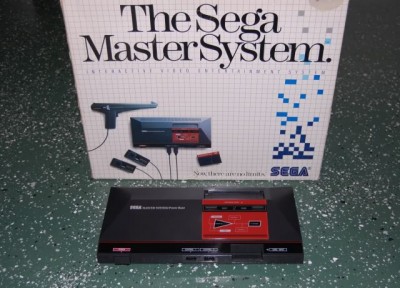Now, There Are No Limits.
Sega Master System General Info:
The Sega Master System was Sega’s Third Generation 8-bit gaming console. It was released in Japan on October 20, 1985 to be a competitor to the popular Nintendo Entertainment System. The Mark III as it was originally called in Japan not only could play newer titles but as well was 100% backward compatible with the Sega SG-1000 line of consoles. The Mark III even had a built in card slot so it could play SG-1000 games that required the Card Catcher add-on. Later in Japan the Mark III was revamped and renamed to the Master System in 1987 and had the Yamaha YM2413 FM sound chip, Rapid Fire Unit, and 3-D glasses adapter all built right into the system. These were all sold as add-on units for the previous Mark III and North American Master System. In June of 1986 less than a year after the release of the NES in North America the Sega Master System made its way to western shores. The Master System retailed for around $200.00 and failed to ever match the popularity of the NES in North America or Japan. Because of the poor sales of the Master System no other markets saw the added features of the built in 3D glasses support, Rapid Fire or the Yamaha FM chip that was inclued on the redone Japanese Master System. In 1988 Sega sold the rights to the Master System to the toy manufacturer Tonka but they where not able to market the system to North America any better than Sega had done. The Master System was very successful in Europe and was able to go head to head with Nintendo. The Master System did well enough in Europe that Sega decided to open the Sega Europe division to handle sales in that region. After the success of the Master System in Europe and the ever growing success of the Genesis / Mega Drive worldwide Sega decides to buy back the rights of the Master System and releases the new redesigned Master System II. The Master System II was small and cheaper to produce due to It not having the card slot or AV output. Sega never was able to match the sales of the Nintendo in Japan and North America so they launched the Master System in other regions where the Nintendo wasn’t released. Brazil had the biggest Success with the Master System Console and the unit saw over 5 redesigns and is still sold there even now. The Master System 3 is the newest console in Brazil and has no cartridge slot but has 131 games built into the system. Also in Brazil a lot of the games were redesigned using different characters that were popular there and many games were released there that never got released anywhere else in the world.
Specs: (From wikipedia)
* CPU: 8-bit Zilog Z80A
o 3.546893 MHz for PAL/SECAM, 3.579545 MHz for NTSC
* Graphics: VDP (Video Display Processor) derived from Texas Instruments TMS9918
o Up to 32 simultaneous colors available (one 16-color palette for sprites or background, an additional 16-color palette for background only) from a palette of 64 (can also show 64 simultaneous colors using programming tricks)
o Screen resolutions 256×192 and 256×224. PAL/SECAM also supports 256×240
o 8×8 pixel characters, max 463 (due to VRAM space limitation)
o 8×8 or 8×16 pixel sprites, max 64
o Horizontal, vertical, and partial screen scrolling
* Sound (PSG): Texas Instruments SN76489 (note that the Sega Master System, Game Gear, and Mega Drive / Genesis used a slightly altered clone of the newer SN76489A, while the older SG-series used the original SN76489)
o 4 channel mono sound (3 Square Waves, 1 White Noise)
o 3 tone generators, 10 octaves each, 1 white noise generator
* Sound (FM): Yamaha YM2413
o mono FM synthesis
o switchable between 9 tone channels or 6 tone channels + 5 percussion channels
o Included as built-in “accessory” with Japanese Master System (1987)
o supported by certain games only
* Boot ROM: 64 kbit (8 KB) to 2048 kbit (256 KB), depending on built-in game
* Main RAM: 64 kbit (8 KB), can be supplemented by game cartridges
* Video RAM: 128 kbit (16 KB)
* Game Card slot (not available in the Master System II)
* Game Cartridge slot (not included on newer Brazilian models, as these have built-in games)
o Japanese and South Korean consoles use vertical shaped 44-pin cartridges, the same shape as SG-1000 and Mark II
o All other consoles use 50-pin cartridges[8] with a horizontal shape
o The difference in cartridge style is a form of regional lockout
* Expansion slot
o Unused, pinout compatible with 50-pin cartridges (but opposite gender) in all regions
Original Sega Master System
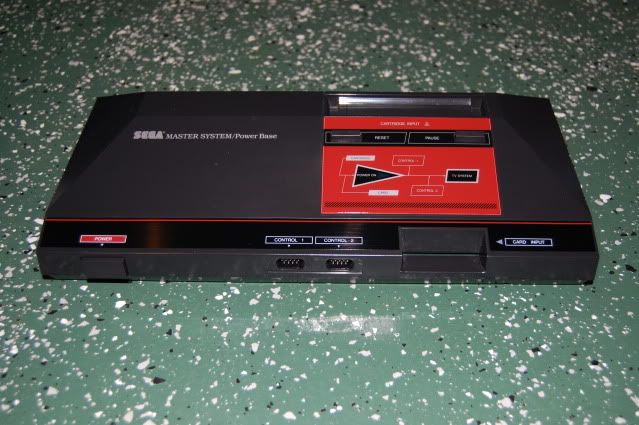
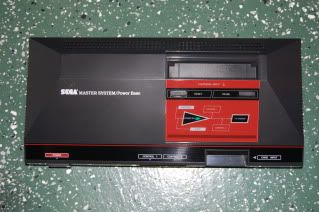
Card Slot and Cartridge input of the Master System.
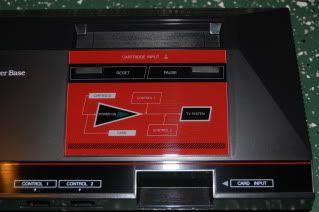
Inputs / Outputs on the Master System.
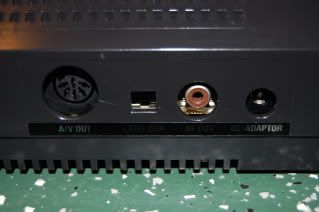
Controller ports on the Master System.
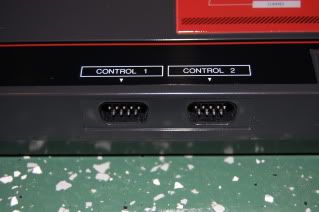
Master System Controller
The Master System uses a 2 button controller that’s a lot like the Nintendo Entertainment Systems controller minus the Start and Select buttons. As well as being able to use the original 2 button Master System controller you can also use a Genesis / Mega Drive Controller on your Master System.

AC Adapter for the Original (US) Master System
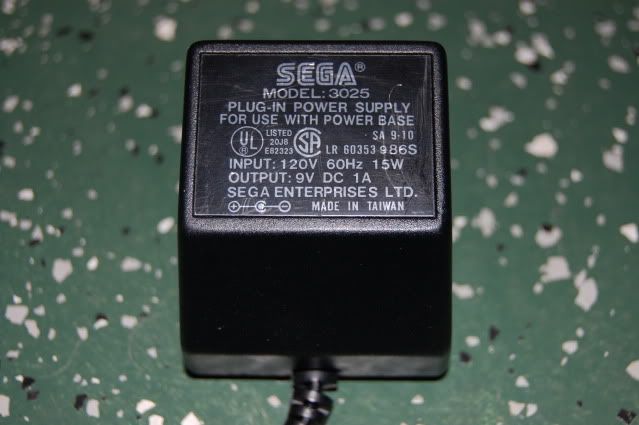
Master System Light Phaser
The Master System Light Phaser was made to look like the guns used by the characters in the Japanese anime Zillion. Tatsunoko Production and Sega produced the anime series and later Sega made 2 games for the Master System based off the anime Zillion and Zillion II.
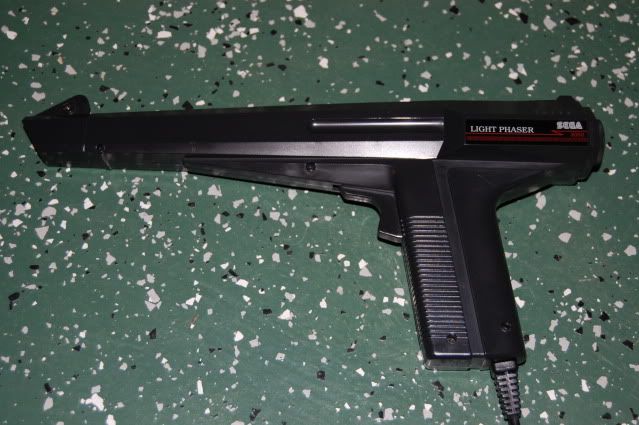
Master System 3-D Glasses
Sega was the first to bring 3-D gaming to the home console. There wasn’t a lot of 3-D games released for the system and because the card slot was removed from the Master System II console the 3-D glasses will only work with the original Master System.
3-D Games:
* Blade Eagle 3-D
* Line of Fire (hold buttons 1 and 2 while switching the computer on for 3-D mode)
* Maze Hunter 3-D
* Missile Defense 3-D (also requires the Light Phaser gun)
* Out Run 3-D (can also be played in 2-D mode without glasses)
* Poseidon Wars 3-D (can also be played in 2-D mode without glasses)
* Space Harrier 3-D
* Zaxxon 3-D (Playable in 2-D via a code)

Master System Video made by Gamester81
Sega Master System II
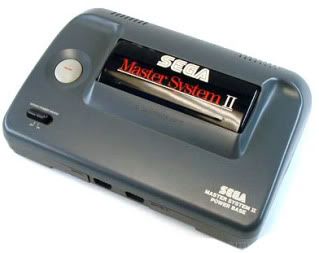
Japanese Sega Mark III
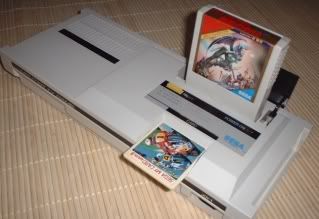
Commercials:
Cleaning your Carts
Here is a picture of everything I use when cleaning my cartridge games. You can pick-up everything I have fairly cheap and this will bring any nasty game back to life.
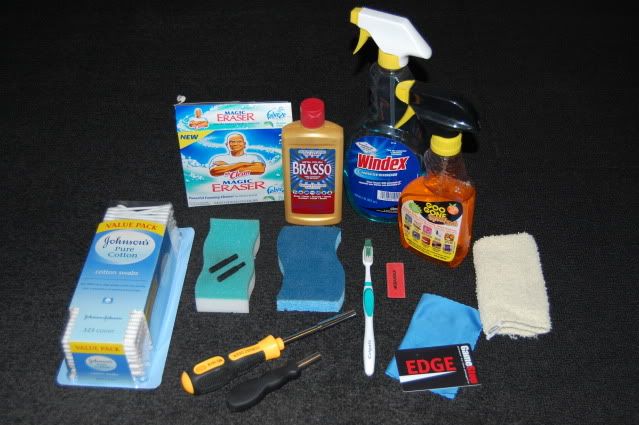
To clean cartridges I first use the games bits with a handle to open the game up. (SMS carts can be opened using a Philips head screwdriver.) Then I use Brasso Brass Polish on the contacts with a old rag. After the contacts are all shining I use a Q-Tip with Windex to remove any of the Brasso that may be left still on there. I have got a hold of one or two carts that were so dirty I had to use a very lightly abrasive sponge to scrub the contacts with Brasso or a eraser then clean them with Windex. Now I clean the inside of the cart case with Windex making sure the part around the contacts get clean. Next put the cart back together and then clean the outside with Windex making sure not to spray directly on the label or rub very hard on it. I use a toothbrush to clean out any cracks or lines on the cart with Windex. If there are marker marks or names on the cartridge you can use the Magic Eraser on it to remove it very easy. Also if you have any stickers on the game case or on the game you can use Goo Gone and remove them with ease. DO NOT USE GOO GONE ON A CART LABEL! Finally to clean the console I use a GameStop EDGE card with a microfiber cloth. I use the microfiber cloth because no lint or cloth fibers are going to be left behind with it but you can use another kind of thin but sturdy cloth in its place.
Sega Master System Games
The Challenge Will Always Be There. Sega Master System Games Standard Master System Game Complete. Up close with the Master... [LEARN MORE]
